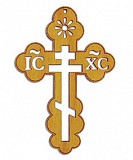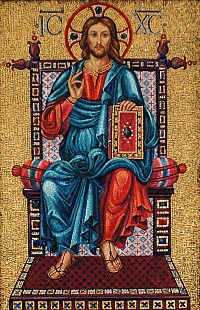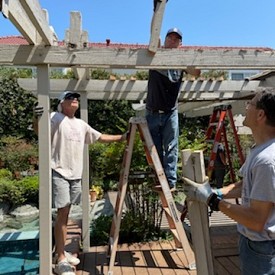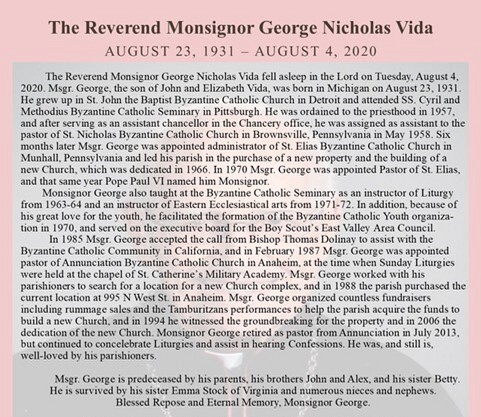Byzantine Catholics are followers of Jesus Christ, the eternal Son of the Living God, who in His great mercy came into the world and assumed our human nature by becoming a man so that He could save us from our sins by His passion, death, resurrection and glorious ascension to Heaven. We are the witnesses to God’s saving action in human history, and the bearers of the Good News of Christ to the ends of the earth.
The Byzantine Catholic Church is the New Testament Church led by the Holy Spirit.
The Byzantine Catholic Church traces its foundation to the 12 Apostles of Christ who were the companions of Jesus as he walked on this earth some 2000 years ago. After the descent of the Holy Spirit at Pentecost (Acts 2:1-4), the Apostles began to proclaim the Gospel, first to Jerusalem, then to the Gentiles.
The first mission of the New Testament Church to the Greek-speaking Gentiles of the Levant was to Antioch, in the Roman province of Syria, where "the disciples were first called Christians" (Acts 11:26). Antioch became the staging area for the great missionary journeys of the Apostle Paul, which resulted in the foundation of a string of Greek-speaking Christian communities in Asia Minor (present-day Turkey) and Greece. Similar missionary journeys were undertaken by other Apostles throughout the Hellenized Eastern Mediterranean, as well as deep into the heart of the Latin West, to Rome itself, the capital of the Empire. As the Christian Church grew, each nation and culture who received the Gospel in turn influenced the growth of the Church. Even at a relatively early stage in the history of the Church, two major heritages developed and remain with us today: the Eastern or "Greek" tradition, and the Western or "Latin" tradition.
The Church in the West had its principal center at the Imperial capital of Rome, and is known in our present-day as the Roman Catholic Church.
The Church in the East grew and developed from the Churches in Jerusalem, Antioch and Alexandria. These three Eastern centers shared a common language, Greek, and similar mode of discourse which formed the basis for the subsequent development of the Eastern Christian tradition. The Byzantine Catholic Church shares in the inheritance of the first Greek-speaking Christian communities of the Eastern Mediterranean world, founded by the Apostles of Jesus Christ.

Figure 1: In the chart above, Annunciation Byzantine Caholic Church falls into the category of Ruthenian rite churches.
The Byzantine Catholic Church shares in the inheritance of the Byzantine Religious Culture of the Christian East
A landmark event in the history of the Church, and particularly the Eastern Church, was the decision in 325 by the Roman Emperor Constantine to move the Imperial capital from Rome to Byzantion, a small town on the Bosphorus strait which he renamed Constantinople (and which is presently Istanbul, Turkey). This shift in the secular political balance had a dramatic impact on the Eastern Church, for a new secular and religious center – Constantinople – was created in the heart of the Christian East. The Eastern Roman, or "Byzantine", Empire centered on Constantinople was a Christian Empire that flourished for over 1,000 years, and which engendered a new and unique culture infused with Christianity. Naturally, the Church based in the capital city of Constantinople gradually came to have a pre-eminent influence in the Christian East, spreading a religious culture that was both a synthesis and dynamic restatement of the existing strands of Eastern Christian culture that had been cultivated in the Greek-speaking world – the "Byzantine" religious culture. Byzantine Catholics in America are the spiritual descendants of Christians in Central and Eastern Europe and the Middle East who are the heirs of this Byzantine religious culture, and who therefore trace their spiritual heritage to the Great Church of Constantinople, known as Hagia Sophia (The Church of Holy Wisdom).
The spiritual heritage of the Byzantine Catholic Church is the same given to us by the Apostles and which matured in the Christian East, during the period of the Byzantine Empire. This heritage includes the doctrines, liturgical practices and underlying theology and spirituality which come to us from the Christian Church of the Byzantine Empire. This heritage is shared among all of the Christian peoples, regardless of ethnicity or nationality, who trace their spiritual roots to the Great Church of Constantinople, and the Byzantine religious culture which grew from that Church. From the First Millennium, Christians of the Byzantine tradition have referred to themselves as "Orthodox Christians". Byzantine Catholics are Orthodox Christians who embrace full communion with the Church of Rome and its primate, Pope Benedict XVI, the successor of St. Peter, the first among the Apostles. Sadly, however, the break in communion between the Orthodox East and the Catholic West of 1054 still affects us today, as our communion with Rome means we are not in full communion with our mother Orthodox Church. We pray for the day when the Churches will again be one.
Byzantine Christian Worship: God is With Us
Byzantine Catholic worship joyfully celebrates the presence of the Kingdom of God on Earth in and through its divine services and liturgical life. Byzantine Catholics are witnesses to the reality of the Resurrection and Ascension of Christ, and follow Christ, in and with Him, to His heavenly Kingdom in the Divine Liturgy, the principal liturgical service of the Byzantine Church. In the Divine Liturgy, we begin worship by assembling together as the Body of Christ, and celebrating the presence of Christ among us with psalms and hymns. Standing attentively in His presence, we are taught by His Words in the Epistle and Gospel, and learn how to apply the Gospel to our lives in the sermon. We then respond to God by freely offering the sacrifice of our own lives to Him in the form of bread and wine, and, uniting our sacrifice with Christ’s own eternal sacrifice, we ascend with and in Christ to His table in His heavenly Kingdom, where He feeds us with the gift of His Body and Blood, transforming us into His Body, making us bearers of Christ and partakers in His nature, and uniting us with Him in His Kingdom. Following the Divine Liturgy, we return to the world as "witnesses to what we have seen" in the unfolding of the Kingdom of God before our eyes, and as missionaries to the world, sanctifying it with the presence of Christ.
Byzantine Catholic worship also celebrates the time of salvation in which we live, sanctifying the time of the world with the presence of Christ at regular periods each day. For Byzantine Christians, following the Jewish tradition of reckoning time, the day begins at Vespers, the ancient service of evening prayer which makes present the finality of the present world and the dawn of the eternal new day in Christ, celebrating the birth of theKingdom of God which itself begins with the end of this world, with the ‘evening’ of this world. At Vespers, we chant psalms and hymns that celebrate the creation and fall of this world, and its redemption, renewal and transfiguration inaugurated by Christ’s Death and Resurrection. At Dawn, the Byzantine Church runs to greet the Risen Lord in the prayer service of Matins (Greek: Orthros), where the dawn of new life made possible through the Resurrection of Christ is made present in psalms, chants and hymns. At Matins, we praise the dawn of the ‘day without evening’, and glorify God who hasfulfilled all things in Himself. During the course of the day, the Byzantine Church remembers the saving presence of God, and in particular the events of Christ’s suffering passion for us, in a series of brief services known as the Divine Hours.
Byzantine Christians, in celebrating the divine presence among them at worship, recognize this presence in all senses and forms of expression, realizing that with the advent of His Kingdom, Christ has filled all things with Himself, and made all things sacred and beautiful in His sight. Byzantine Christian worship is therefore holistic in content and expresses and manifests this beauty in various forms -- ancient sacred religious poetry and hymns, moving chanting styles, bright, brocaded vestments, the burning of incense, the use of candles, the veneration of icons. The Byzantine Christian worships God with his whole person, and recognizes the presence of God in all of his senses, bearing witness to the fact that, in Christ, there is no distinction between ‘sacred’ and ‘profane’, but that in the Kingdom of God, which is manifested in this world by the Church, all things are fulfilled in Christ to be what they were created to be – namely, a means of communion with Him.
Inside Our Churches: God's Kingdom on Earth
Byzantine Catholic churches are designed to manifest, or make present, in their architecture and arrangement, the presence of the Kingdom of God on Earth. The sanctuary, located behind an icon screen, manifests Heaven, the dwelling place of God. The Holy Table makes present, in a particular way, Heaven, and manifests the Lord’s banquet table to which all are called. On the Holy Table are placed the Book of Gospels and the Holy Gifts during the Divine Liturgy, and in the center of the table stands the tabernacle (artopohorion) containing the reserved Eucharist.
Shining forth from heaven, the divine light transfigures and ‘defies’ the figures depicted in the icons placed on the icon screen (Iconostasis), transforming them by God’s uncreated energies into bearers of the divine nature. Icons, whether depicted on the icon screen or elsewhere, are therefore a graphical depiction of the saving energies of God and their tremendous transformative and transfigurative power – they are a graphic and tangible manifestation of salvation in Christ, of what transfigured life looks like, and where our lives are hopefully leading us. Unlike other religious art, icons are also a participation, here and now, in the event or person depicted in the icon – icons make present these events and persons for us. We therefore show icons the same respect we would for the event or person represented in them, because these are, in reality, present before us in the form of the icon. When we venerate icons, our veneration is therefore directed at the event or person depicted, and not at the picture itself or the wood on which the icon is painted. Icons are venerated, but are never worshipped, for worship belongs to God alone. In fact, in venerating the persons depicted by icons, we are in fact rendering glory and praise to God, who by His great mercy and love has transfigured these persons and made them holy.
The main body of the church, or nave, is the gathering place of the assembly, the Body of Christ. Its walls are covered with icons which make present the reality of the communion of the entire Body of Christ, in heaven and on earth – and, therefore, of our communion with the saints of God throughout the ages. When we celebrate the Divine Liturgy, we are co-celebrating with the heavenly hosts of angels and saints – and the iconography that surrounds us in the nave manifests this reality for us in a graphic way. The nave, then, manifests the fullness of the reality – in heaven and on earth -- that is the Church, the Body of Christ. Standing in the nave as the Church, we look forward to the sanctuary, as we, in our individual lives in this world, and collectively as the Church, look forward to the ultimate coming of the Kingdom of God. During the Divine Liturgy, the Kingdom of God is revealed and made manifest to us, to the Church, and we approach the sanctuary to receive communion with God, and thereby to experience here and now the Kingdom of God on Earth. The design of the church building, therefore, reflects our understanding of the Church, and the central facets of our Christian faith regarding the meaning and goal of our lives. The church building manifests our Christian faith in graphic terms, and allows us to participate in that faith in a tangible way with all of our senses, with our entire person.
The Sacramental Mysteries
The entire work of Christ – his birth, death, resurrection, and ascension – has been undertaken to provide to us the gift of New Life in Christ. This gift of New Life is given by Christ to the Church in the Holy Spirit – and, in a special and profound way, through the Holy Mysteries, or sacraments, of the Church. Every Holy Mystery is a participation in the New Life that is Christ’s gift to us in the Church, and is a participation, in this world, in His Heavenly Kingdom which is to come.
In the Mystery of Holy Baptism, we are individually baptized into the death and resurrection of Christ, being regenerated (or reborn) in Christ. Baptism is nothing less than our personal participation in the death and resurrection of Christ, our personal appropriation of His death and resurrection as my own. Following the command of the Lord to His Apostles, we are baptized in the name of the Father and of the Son and of the Holy Spirit (Mt 28:19), being immersed three times in the ‘laver of regeneration’, and are called by name to join with the Body of Christ, the Church.
Holy Chrismation, in which we are anointed with the Holy Chrism, bestows the gift of the Holy Spirit upon each of us individually. Chrismation is our personal participation in the descent of the Holy Spirit at Pentecost. Sealed with the Holy Chrism, we are anointed as prophet, priest and king, and are given the means – the Holy Spirit Himself – needed to grow in holiness and live the Christian life; we are given individually "the Comforter, the Spirit of Truth", who will guide us throughout our lives as Christians.
The Holy Eucharist, the sacrament of Christ’s Body and Blood, provides us with the spiritual food we need to sustain us on our Christian journey. We are told by the Lord Himself that unless we eat his flesh and drink his blood, we will have no life in us, and it is therefore in the gift of the Eucharist that we receive this life, which is Christ Himself, and are united to Him, becoming His Body. The Byzantine Church, following the ommand of the Lord to ‘let the little children come to me’ (Mt 19:14), administers the Holy Mysteries of Baptism, Chrismation and Eucharist to infants on the same day, so that they become full members of the Body of Christ, fully integrated into the Church, and full participants in the gift of New Life in Christ.
Having received the New Life in Christ as a gift of the Trinity in the Church, we, in our human frailty and weakness, fail to live this New Life, and often revert to the old life – the old life which is not life at all, but death. Through the Mystery of Holy Confession, in which we admit and confess our failure to live the New Life, we are reconciled both to Christ and His Body, the Church, and are empowered again through God’s grace to live the New Life in Christ. In Holy Confession, we repent of our sins, and receive forgiveness and absolution, and the grace to persevere in this world to live the New Life in Christ, in spite of our failures and shortcomings.
Although we have received the gift of New Life, living as we do in this world, we are not immune to suffering and sickness. When Our Lord walked among us on Earth, He was not indifferent to human suffering, but repeatedly reached out to those suffering and in need, healing them with His divine power. In the Mystery of Holy Anointing with Oil, we are anointed with blessed oil for our illnesses, both bodily and spiritual, which sacramentally makes present to us through prayer, oil and human touch the healing ministry of Christ. The entire Church celebrates this Mystery on Holy and Great Wednesday in anticipation of the Holy Pascha, the Feast of the Resurrection.
God is revealed to us not as a sole, solitary being, but as a Trinity of Three Persons, living in an endless and perfect communion of unselfish, self-emptying love. The New Life in Christ is this life of the Holy Trinity – a life of unselfish love for others. This life of self-giving, self-emptying love is most beautifully and dramatically expressed in this world in the Mystery of Holy Matrimony, in which a man and a woman are called together to live as one through mutual self-giving and selfless love, thereby conquering themselves and growing in holiness through Christ. In the Mystery of Holy Matrimony, the couple are crowned with the divine grace and strength to grow together in love and holiness, and live the New Life of Christ more abundantly.
The Church, the Body of Christ, is a universal priesthood of believers. Yet among this universal priesthood, some are called to serve the Church in a particular way in the sacramental and liturgical life of the Church. The Mystery of Holy Orders calls men to serve the Body of Christ as deacons, priests and bishops through the laying on of hands, in which Christ Himself gives them the grace and power to perform this service in His name for the sake of His Body.
An Invitation
All Christians are witnesses to the New Life that Christ has given to us in His Church. Byzantine Catholics recognize this and know that there are many good people outside the Catholic and Orthodox Churches and that these other religions can and do bring their members close to God. The Byzantine Catholic faith, however, is not simply a way of life, a set of doctrines and beliefs, ritual practices and customs. Our Byzantine Catholic faith is Life itself. It is a Life that is truer, fuller, more abundant and more authentic than any other life – it is Life which is everlasting and has no end, and over which even death has no power. We warmly invite you to join us and share, even now, in this New Life in Christ.
Welcome Home!
Are you a Byzantine Catholic who is no longer active in the Faith? Are you not a member of any Church or maybe find that the Church you currently belong to is not a home to you? To you we issue a special invitation to come join us. We both need and want you as a member of our family






